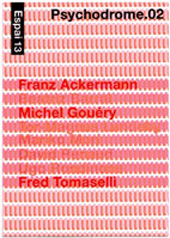- Exhibition program
- Cycle: Psychodrome
- Artist
- Franz Ackermann, Michel Gouéry i Fred Tomaselli amb monochrom
- Dates
- —
- Curated by
- Grazia Quaroni i David Renaud
This is the second phase of Psychodrome, our journey along the paths of disorder. Disorders of the imagination, disorders of consciousness through images; disruption and interference between reality and illusion, dreams and everyday life, sleep and wakefulness; the absence of linearity, of beginning and end; a burst of colours and forms, the creation of motifs obsessively repeated ad infinitum. All this is Psychodrome, which could only be materialised in round forms, and therefore an architectural model has been designed with an evolving structure of concentric circles, rather like labyrinths, spirals or hoops.
Whereas in “Psychodrome.01” the keyword was “hypnosis”, here it is “vision”. Vision often borders on hallucination, which can come about from a particular state of consciousness or be induced by natural or chemical substances. One of the features of this phenomenon, which involves the physical and the psychic in a single entity, is simultaneity and the rapid sequencing of images. And it is fast-moving, simultaneous images that fill the entire Espai 13, which is not just the space that receives the works but also becomes the support for the work itself, and thus the place of its creation and its existence. It is indeed an exhibition of painting – but an exhibition in which the pictures are often not painted and in which the painting often has no picture but emerges from the space itself.
FRANZ ACKERMANN
Born in 1963 in Neumarkt St. Viet, Germany
Lives in Berlin
As is his custom, Ackermann has worked directly on the walls. Waterfall burning (2002) already announces in its title the particular aspect of simultaneity that is defined by the word “synaesthesia”, a composition of sensorial stimuli that appear to be contradictory but are merely complementary. Synaesthesia is what allows us to “feel” a colour or “touch” a sound, and in this case it is what allows water to burn and the waterfall to cascade upwards. Ackermann’s forms explode on the wall, dominated by an unstable perspective that comes straight at the viewer, almost landing on top of him in an apocalypse of colour. This sense of chaos, this painting without beginning or end, is of course the result of an extremely precise design. In order to assert the fact that it is a work anchored in reality, and particularly in the urban reality of every city in the world, we often find one or more photographs embedded in the painting.
MICHEL GOUÉRY
Born in 1959 in Rennes, France.
Lives in Paris and New York
Simultaneity is also the order of the day with Michel Gouéry. In one and the same picture we find motifs and portraits, large and small elements, figuration and abstraction, monochrome and colour. Undaunted by a bold approach, Gouéry uses the paint itself as the element that links everything together, both reality and unreality, both history of art and current affairs or politics. Tantrism and illustrated comic strips, Impressionism and pornography, the Baroque and caricature exist happily side by side on the same canvas, and it is precisely there that they find their coherence. The artist’s insolence manages to totally convince the viewer of the need for each of these different elements and makes us feel we are looking at an extremely cohesive work.
FRED TOMASELLI
Born in 1956 in Santa Monica, California, USA
Lives in New York
Fred Tomaselli produces pictures without painting. His motifs of whirlwinds and galaxies, impregnated with literary references, reveal a new kind of universe, a distorted utopia that destabilises the viewer. His works are collages, to be viewed either from a distance, in order to appreciate their cosmic, visionary effect; or close up in order to discover their meticulous detail and the variety of materials that are not always licit or legal. We therefore discover on close inspection what provokes these imaginative visions that we have enjoyed from afar: pills, leaves, insects and a mass of miniscule objects of various kinds are embedded in resin, arranged with the utmost precision to form a perfectly flat surface. In presenting the substances that can produce hallucinations alongside an overall visionary image, Tomaselli shows cause and effect in full circle, the before and the after simultaneously, distorting time and space in infinite declensions.


